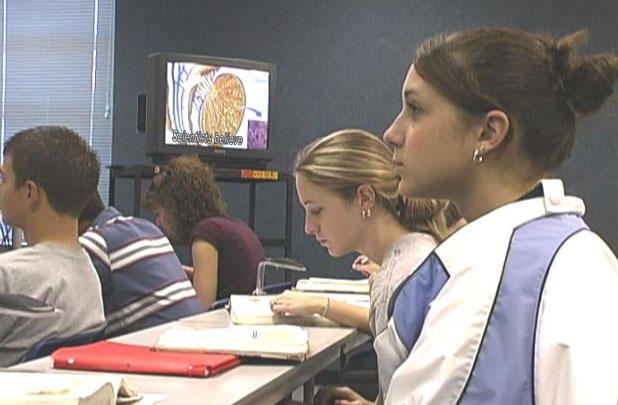<< Learning Center
Media Accessibility Information, Guidelines and Research
Equal Opportunities With the DCMP
By Wanda Shipman
Students who are deaf or hard of hearing communicate in concepts rather than words or sentences. It is often difficult for these individuals who learn by sight rather than sound to understand written language that has never been heard. It can be even more frustrating for them to meet academic standards sitting in a class attempting to comprehend lectures, conversations, and videos that have no sound.

As a result, the Described and Captioned Media Program (DCMP), funded by the U.S. Department of Education, has made it their mission to aid students in their learning by providing captions to educational media for free loan. Anyone who works with students who are deaf or hard of hearing is eligible to borrow from the opencaptioned collection of 4,000 titles.
The titles available from the DCMP collection can be used in both the classroom and at home. By using captioned media, deaf students are better able to comprehend the subjects being taught in schools. In this way, the sound that is being released from the speakers is made clear through the words on the screen.
Despite the lack of equal educational opportunity for deaf students, each state has created a system of standards that must be met by all students. These educational standards have become the criteria of accountability for both teachers and students. This is one reason that it is imperative that all students have the same type of learning resources readily available regardless of disability.

Consequently, public and residential teachers have come to appreciate the DCMP as a resource for introducing new material to deaf or hard of hearing students in their classrooms. By viewing captioned media, students of all learning levels are excelling in subjects that were at one time too overwhelming. Deaf students no longer need to strain at the screen to determine the message from the speaker on- or off-screen.
Instead, the students have the opportunity to focus on the lesson clearly displayed in the captions alongside the images of the media. As the students read the captions, they have the opportunity to learn the material faster and more comprehensively.
For instance, Cinnie MacDougall, a tenth-grade reading teacher at the South Carolina School for the Deaf and the Blind, has benefited from using the DCMP media in her classroom. After reading and analyzing Shakespeare's Romeo and Juliet, she showed her class the modern movie version from the DCMP collection. Ms. MacDougall noted that the students learned to recognize the vocabulary and sentences as the captions were displayed: "It has helped to enhance their literary experience."

In addition to captioned media helping students better understand the material, such as in Ms. MacDougall's classic literature class, literacy skill is developed and strengthened. Words that had never been heard are associated with images that are understood. In this way, students learn the skills needed to read textbooks, novels, newspapers, and even to write themselves.
Outside of the world of literature and writing, students spanning from preschool to college have access to captioned media pertaining to arts, history, government, sports, and even topics related to improving job, computer, and home repair skills. The opportunity for equal education has become achievable with captioned media from the DCMP.
To summarize, students who are deaf or hard of hearing deserve access to any resource that will aid in their meeting the state academic standards as well as their own personal goals. Teachers, in turn, have found the DCMP and its captioned media to be a valuable, accessible source in achieving equaleducational opportunity in the classroom.
Literacy is only one of many areas that are being developed and enhanced by the use of captioned media. Not only are these students becoming competent in their ability to read and write, but they are also building on their knowledge with other subjects taught in class. With captioned media from the DCMP, students are given an equal opportunity to learn.
About the Author
Wanda Shipman is a former media specialist from the South Carolina School for the Deaf and the Blind. She retired in 2003 after 31 years of teaching. She and husband Jimmy moved to the family farm in southern Alabama. Wanda does contractual work for the Described and Captioned Media Program.
Tags:
Please take a moment to rate this Learning Center resource by answering three short questions.
